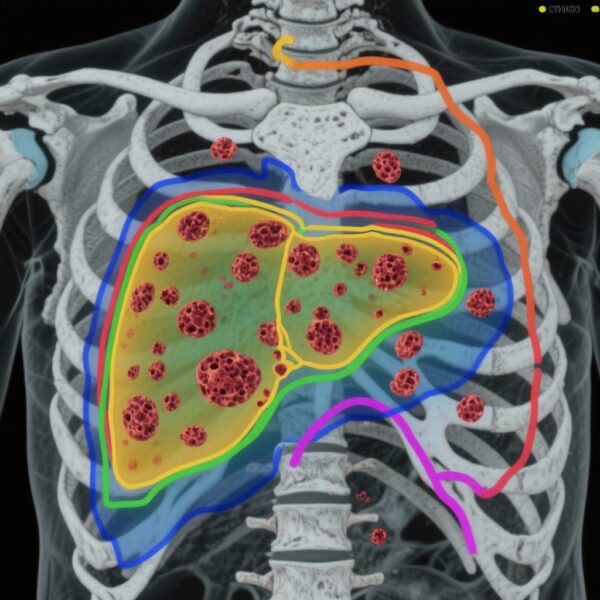Highlights
– In the phase 3 ADAPT SERON trial, efgartigimod produced a statistically significant improvement in MG‑ADL at 4 weeks versus placebo in patients with AChR‑antibody–negative generalized myasthenia gravis (gMG) (least squares mean change −3.35 vs −1.90; P = .007).
– Benefit was most notable in MuSK‑antibody–positive participants (−4.24 vs −1.89; treatment difference −2.35; P = .01).
– The triple‑seronegative subgroup did not achieve statistical significance at the 4‑week primary endpoint (treatment difference −0.98; P = .15); LRP4 subgroup was too small for comparative analysis.
– Adverse events were mostly mild to moderate and consistent with previous efgartigimod experience; three deaths were reported across parts A and B, one of which in the open‑label extension was considered potentially related to therapy.
Background and Unmet Need
Generalized myasthenia gravis (gMG) is an autoimmune neuromuscular disorder characterized by fluctuating skeletal muscle weakness and fatigue. The disease is immunologically heterogeneous: the majority of patients have pathogenic autoantibodies directed at the acetylcholine receptor (AChR), but an important minority (roughly 15%–20%) are AChR‑antibody–negative. The AChR‑negative group includes patients with antibodies to muscle‑specific kinase (MuSK; ~5%–10%), LRP4 (~1%–5%), and a triple‑seronegative subset (~10%) who lack detectable antibodies to AChR, MuSK, or LRP4.
These seronegative and non‑AChR antibody subtypes present diagnostic and therapeutic challenges. MuSK‑positive disease frequently follows a severe and bulbar‑predominant phenotype and may respond differently to standard immunotherapies; triple‑seronegative patients are a heterogeneous population in whom underlying pathogenic mechanisms may be variable and often poorly characterized. Historically, many clinical trials have excluded or underrepresented AChR‑negative patients, leaving a gap in evidence for therapies in these groups.
Mechanism of Action: Rationale for FcRn Antagonism
Efgartigimod is a neonatal Fc receptor (FcRn) antagonist that reduces circulating IgG by blocking FcRn‑mediated recycling of IgG, thereby accelerating catabolism of IgG antibodies. Because pathogenic autoantibodies implicated in MuSK and LRP4 disease are immunoglobulin G (IgG) subclasses, FcRn antagonism is mechanistically plausible across antibody‑mediated MG subtypes. This provides a rationale to evaluate efgartigimod beyond AChR‑positive patients, including MuSK‑ and LRP4‑positive disease and selected seronegative patients who may harbor low‑titer or undetected pathogenic IgG.
Study Design: ADAPT SERON (Phase 3)
ADAPT SERON is a randomized, double‑blind, placebo‑controlled, phase 3 trial presented at the AANEM 2025 meeting that enrolled adults with AChR‑antibody–negative generalized MG, MGFA class II–IV, and an MG‑ADL score ≥5 on stable baseline therapy. The trial had two parts: Part A was an 8‑week randomized phase in which participants received four weekly intravenous doses of efgartigimod 10 mg/kg or placebo followed by 5 weeks of observation. Part B is an ongoing open‑label extension in which participants receive initial cyclic dosing (4 weeks on, 4 weeks off) and subsequently individualized cycles.
Key baseline characteristics: the randomized cohort included 58 patients assigned to efgartigimod and 61 to placebo, mean ages approximately 50–52 years, and about three‑quarters female. Baseline mean MG‑ADL scores were 9.9 and 9.4 in the efgartigimod and placebo groups, respectively. Serostatus subgroups included MuSK‑positive (n = 40), LRP4‑positive (n = 5), and triple‑seronegative (n = 73).
The prespecified primary endpoint reported for Part A was least squares mean change from baseline in Myasthenia Gravis Activities of Daily Living (MG‑ADL) score at week 4.
Key Results
Primary outcome (overall AChR‑Ab–negative cohort): At week 4 the least squares mean (LSM) change in MG‑ADL was −3.35 for efgartigimod versus −1.90 for placebo (treatment difference −1.45; P = .007). This met the trial’s primary statistical threshold and indicates a statistically significant improvement in daily function favoring efgartigimod at the prespecified timepoint.
Subgroup results
MuSK‑positive subgroup (n = 40): Efgartigimod produced a robust treatment effect with LSM change −4.24 vs −1.89 for placebo (treatment difference −2.35; P = .01). These data indicate a clear and clinically meaningful benefit in this subgroup, which has historically been difficult to treat and often excluded from trials.
Triple‑seronegative subgroup (n = 73): LSM change was −2.80 for efgartigimod versus −1.82 for placebo (treatment difference −0.98; P = .15). The difference did not reach statistical significance at the primary endpoint. Investigators note that some patients in this subgroup continued to improve during the open‑label extension, suggesting that delayed or more gradual benefit may occur in a subset.
LRP4‑positive subgroup (n = 5): Mean MG‑ADL change from baseline to week 4 was −2.8 (SD 1.8) in the treated participants. No between‑group comparison was possible due to the very small sample size.
Secondary and exploratory measures
The full dataset presented included additional secondary endpoints and open‑label extension observations; presenters emphasized continued improvement in some patients over longer follow‑up, particularly within the triple‑seronegative subgroup in part B. Detailed secondary endpoint statistics (e.g., responder analyses, QMG scores, quality‑of‑life measures) were not fully reported in the summarized presentation and will be needed to clarify the magnitude and durability of benefit across domains.
Safety and Tolerability
Treatment‑emergent adverse events (TEAEs) occurred in 62.1% of efgartigimod recipients versus 49.2% of placebo recipients in Part A. Serious adverse events were reported in 5.2% of the efgartigimod group and 1.6% of placebo recipients. The most common TEAEs (each <10%) included upper respiratory tract infection, nausea, headache, urinary tract infection, and fatigue. Investigators reported no new safety signals relative to prior efgartigimod experience and no consistent changes in serum albumin or cholesterol.
Deaths: There were three deaths in the program as presented. In Part A, one death in the efgartigimod group occurred due to myasthenic crisis and one death in the placebo group was due to large intestinal hemorrhage; neither was judged drug‑related. A death in Part B (open‑label) was described as unexpected and potentially related to efgartigimod; no autopsy data were available at the time of the presentation. The sponsor and investigators are continuing safety assessments and surveillance.
Expert Commentary and Clinical Interpretation
James F. Howard Jr, MD, highlighted that ADAPT SERON addresses a long‑neglected population and provides randomized evidence for an FcRn antagonist in AChR‑negative gMG. Commenting for Medscape, Kavita M. Grover, MD, noted the particularly favorable results in MuSK‑positive patients and suggested that efgartigimod could become an important therapeutic option in that subgroup. Both speakers emphasized the need for longer‑term data, especially for triple‑seronegative patients where the pathophysiology may be more heterogeneous.
Mechanistically, the large effect seen in MuSK‑positive disease is congruent with an IgG‑mediated pathogenic mechanism and supports FcRn antagonism as a logical therapeutic strategy. The more modest and non‑significant results in the triple‑seronegative cohort underline the heterogeneity of that subgroup—some patients may harbor low‑titer or atypical antibodies not detected by routine assays, whereas others may have non‑IgG or non‑autoantibody disease mechanisms.
Limitations and Unresolved Questions
Several limitations should inform interpretation and clinical translation:
- Short primary endpoint: The primary assessment at 4 weeks captures early response to a single 4‑week dosing cycle; it does not fully reflect durability of effect or longer‑term safety.
- Subgroup sizes: Some subgroups, particularly LRP4‑positive patients, were too small to permit definitive conclusions. The triple‑seronegative group is heterogeneous and may dilute treatment effect if only a subset is antibody‑mediated.
- Clinical meaningfulness: Although the primary endpoint reached statistical significance for the overall cohort and MuSK subgroup, assessment of clinical meaningfulness requires integration of responder analyses, quality‑of‑life outcomes, and physician‑reported measures over time.
- Safety signal: The unexpected death in the open‑label extension that was potentially related to therapy warrants careful pharmacovigilance and further investigation.
Clinical Implications and Practical Considerations
For clinicians managing AChR‑antibody–negative gMG, ADAPT SERON provides the first randomized, placebo‑controlled evidence supporting efgartigimod, with particularly convincing results in MuSK‑positive disease. This could expand treatment options for a subgroup that is often refractory to conventional immunotherapies.
Practical considerations include patient selection (confirmed MuSK positivity appears to predict favorable response), monitoring for infection, and counseling about treatment expectations and the need for individualized dosing cycles in longer‑term management. Given the mixed results in triple‑seronegative patients, clinicians should temper expectations and consider enrollment in registries or open‑label extensions where available to better characterize responders.
Regulatory and Research Pathways
Efgartigimod (Vyvgart) received FDA approval in 2021 for AChR‑antibody–positive generalized MG. Argenx has indicated plans to seek label expansion to include AChR‑antibody–negative gMG across subtypes following these data. Additional study and post‑marketing data will be important to define durability of response, optimal dosing schedules for non‑AChR populations, and long‑term safety, including rare serious adverse outcomes.
Conclusion
ADAPT SERON demonstrates that efgartigimod can provide clinically meaningful improvement in MG‑ADL vs placebo in AChR‑antibody–negative gMG at the 4‑week timepoint, with a pronounced effect in MuSK‑positive patients. Results in triple‑seronegative disease were inconclusive at the prespecified endpoint, highlighting biological heterogeneity and the need for longer follow‑up and larger, targeted studies. Safety in the randomized phase was consistent with prior experience, although an unexpected death during the open‑label extension underscores the necessity for continued vigilance.
Overall, these data represent an important advance for a previously under‑studied MG population and support further evaluation of FcRn antagonism as a treatment platform across antibody‑mediated neuromuscular disorders.
Funding and Trial Registration
The study was funded by argenx. ADAPT SERON results were presented at the American Association of Neuromuscular & Electrodiagnostic Medicine (AANEM) 2025 meeting.
References
1) American Association of Neuromuscular & Electrodiagnostic Medicine (AANEM) 2025 abstract and presentation materials for ADAPT SERON.
2) U.S. Food and Drug Administration. Vyvgart (efgartigimod‑alfa) approval information. 2021.
3) Howard JF Jr, et al. (Primary randomized phase 3 ADAPT program publications and prior efgartigimod trials). (See peer‑reviewed literature for the initial approval studies and safety data.)
Note: Detailed peer‑reviewed manuscript(s) reporting ADAPT SERON full results, including comprehensive secondary endpoints and longer‑term follow‑up, were not available at the time of the presentation; readers should consult the final published reports and the FDA for the complete dataset.



![[Lutetium-177]Lu-PSMA-617 Delays Quality-of-Life Decline, Pain Progression, and Symptomatic Skeletal Events in PSMA-Positive mCRPC: In-depth PSMAfore Analysis [Lutetium-177]Lu-PSMA-617 Delays Quality-of-Life Decline, Pain Progression, and Symptomatic Skeletal Events in PSMA-Positive mCRPC: In-depth PSMAfore Analysis](https://news.medxy.ai/wp-content/uploads/2025/11/9d3c0201-d1b3-49f2-a408-3ea3d0347451-600x600.jpg)